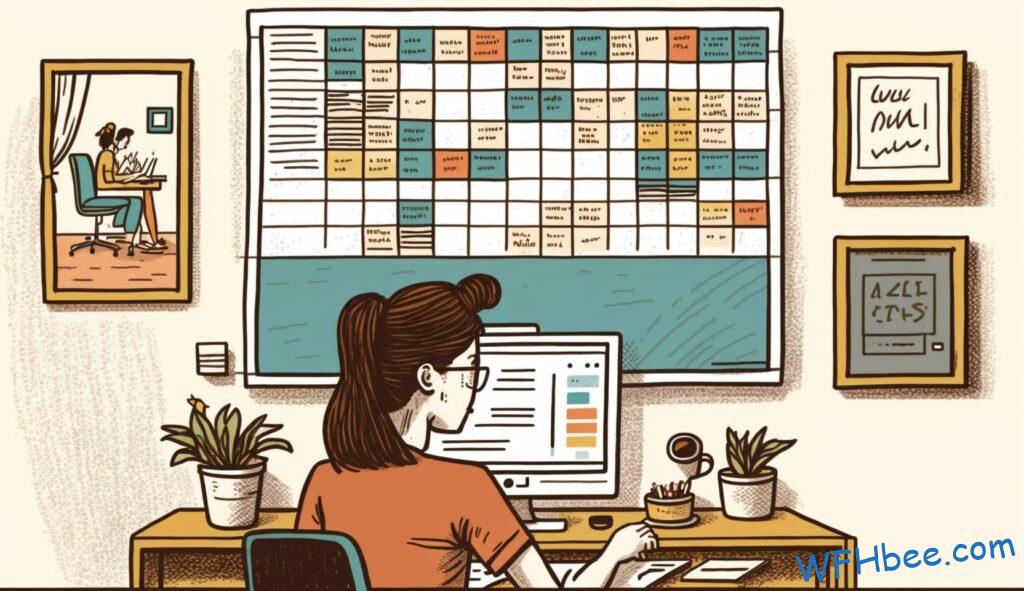Have you ever heard of a 3-2 WFH schedule? It’s an attractive way to structure your work week and achieve the perfect balance between remote and office working. If you’re looking for more freedom in how you spend your days, this might be exactly what you need! In this article, we’ll explore why a 3-2 WFH schedule is such a great option and how it can benefit both employers and employees alike.
We all want to have more control over our lives – especially when it comes to getting stuff done at work. But sometimes, traditional 9-5 office jobs don’t give us that flexibility. That’s where a 3-2 WFH schedule comes in! By alternating between three days in the office and two days working from home (WFH), you get the best of both worlds: collaboration with colleagues while also having time to focus on personal projects or take care of errands.
Whether you’re an employer who wants to give their staff more autonomy or an employee looking for ways to make work/life balance easier, understanding what a 3-2 WFH setup looks like is the first step towards achieving greater success. Read on to learn more about this innovative approach and see if it could help improve your productivity levels!

Here’s what we’ll cover:
Table of Contents

By the way, you may also be interested in this article, which looks into the ideal number of WFH days for hybrid workers.
Definition Of A 3/2 WFH Schedule
Back in the day, one of the most sought-after work arrangements was a 3/2 wfh schedule. This type of remote work schedule is also known as a hybrid work schedule because it consists of two days spent working from home and three days spent commuting to an office or other workplace environment. It’s become increasingly popular among both employers and employees alike who are looking for more freedom while still getting their jobs done.
With this kind of arrangement, you can enjoy the convenience of working remotely on your own terms without sacrificing productivity or collaboration with colleagues.
In short, a 3/2 WFH schedule provides the perfect balance between flexibility and structure – allowing you to make the most out of each day. Plus, with added benefits like avoiding rush hour traffic and maintaining better mental health due to reduced stress levels, it’s no wonder why more people are opting for this type of work setup.

Benefits Of A 3/2 WFH Schedule
A 3/2 WFH schedule offers a range of benefits, from cost savings to increased productivity and improved morale for employees. For employers, the ability to cut overhead costs can be substantial. By reducing office space needs, employers can save on rent or mortgage payments as well as utilities such as electricity and heating. This can equate to thousands of dollars in savings each year depending on the size of their organization.
For employees, having the option to work from home two days per week allows them more flexibility with their time while still benefitting from the same salary they would receive if they worked in an office setting. This often leads to improved job satisfaction and less stress due to no longer needing to commute long distances each day. It also provides employees with more autonomy over their personal schedules which can lead to greater productivity during working hours since they are able to structure breaks when needed throughout the day. Additionally, it has been found that allowing remote working options increases employee morale due to feeling trusted by their employer and included in company decision-making processes.
These benefits make it easy to understand why so many businesses have adopted a 3/2 WFH schedule or are considering doing so in the near future. However, there are some important challenges that should also be considered before implementing this type of schedule into any workplace environment.

Challenges To Consider When Starting A 3/2 WFH Schedule
Starting a 3/2 WFH schedule can be tricky. It is important to consider the following challenges before making the switch:
- Time Management: Working remotely requires more self-discipline and structure than working in an office environment. You will need to adjust your schedule so that you are productive during both work days and off days, while also accounting for other commitments such as parenting or hobbies.
- Mental Health: With no clear delineation between home life and professional life, it’s easy to become overwhelmed when working from home full time. Take steps to ensure your mental health is taken care of by setting boundaries with yourself and others, taking regular breaks throughout the day, and establishing a routine free of distractions.
- Set reasonable expectations for yourself
- Schedule time for leisure activities
- Prioritize sleep
- Maintain communication with colleagues
- Make sure to take breaks from screens
It’s essential to create an effective routine if you want to make this transition successful. Finding balance between work, rest, and play makes all the difference in achieving personal freedom through remote work.

How To Create An Effective Routine Working Hybrid
Creating a daily routine can be compared to baking a cake. The ingredients are the tasks you need to do on any given day, while setting goals is like creating your recipe. Once you have all of the pieces in place, it’s time to start building an effective routine that will help you stay productive and organized.
Start by getting into a rhythm with your sleeping schedule; having consistent sleep times will give you energy throughout the day and make sure that you are well-rested for whatever comes next. Then, plan out each hour of your day so that there is enough room for work or study, meals, exercise and relaxation. When planning out these activities, think about what works best for you – if mornings aren’t your strong suit maybe set aside afternoon hours for more important tasks instead.
The flexibility of a 3/2 wfh schedule allows us to customize our routines even further according to our needs and preferences while giving us more control over our own lives. With careful consideration and practice we can create an efficient system that not only helps us reach our professional goals but also keeps us happy and healthy along the way!

Time Management Tips During Hybrid Work
Time management hacks and productive habits are essential for achieving a 3-2 WFH schedule. To effectively manage your time, you must track it. Utilizing the right tools for tracking can help keep you on task and accountable to yourself. Consider using online calendars, planners, or apps that remind you of important tasks or deadlines ahead of time. Also, breaking down large tasks into smaller steps makes them more manageable and helps you focus better during work hours.
In addition to managing your day-to-day obligations, maintaining work-life balance is key to living a healthy lifestyle while working from home two days per week. Maintaining boundaries in-between work life and personal life allows you to be present in both areas without feeling overwhelmed or overworked. Schedule leisure activities away from your workspace so that when it’s time for rest and relaxation, there are no distractions from unfinished tasks. Additionally, prioritize self care by taking regular breaks throughout the day and exercising regularly to reduce stress levels. This will ensure that you remain energized, focused, and productive each day!
How To Maintain Work-Life Balance Telecommuting
Maintaining a healthy work-life balance can be challenging, especially when working from home. It’s important to take the necessary steps to ensure that you are creating separation between your professional and personal life. To maintain balance while on a 3 2 WFH schedule, it is essential to give yourself time off. This could include taking lunch breaks away from your desk or dedicating part of each day for leisure activities such as exercise, hobbies, or even unplugging completely. Additionally, setting boundaries with colleagues regarding availability will help prevent burnout and preserve your mental health.
It’s also important to stay connected with co-workers by participating in virtual team building activities. These provide an opportunity to socialize without compromising productivity levels. Furthermore, engaging in group discussions outside of regular business hours helps cultivate relationships within teams and build trust among remote workers. By implementing these strategies into your routine, you’ll be able to create a more harmonious work-life relationship and achieve better results overall.

Best Practices For Virtual Communication
In today’s society, virtual communication has become a primary form of connection. Whether it be for work or leisure activities, people are communicating digitally more than ever before. To ensure that virtual interactions remain productive and meaningful, here are some best practices to keep in mind:
- Use the right tools: It is important to have the appropriate technology in place to facilitate successful virtual communication. There are many great options available such as Zoom, Skype, Slack, etc., which allow instant messaging and video conferencing capabilities without needing any software downloads.
- Establish clear goals: Before beginning your virtual conversation, make sure you know what you want to accomplish through dialogue with your remote contacts. Having a list of objectives ahead of time will help keep everyone on track during the meeting.
- Set ground rules: Setting certain expectations between yourself and those you communicate with remotely can prevent misunderstandings and avoid confusion down the line. This could include things like having an expected response time for messages or setting up specific times when participants should be ready for calls/meetings.
- Maintain professionalism: Even though conversations take place over digital platforms instead of face-to-face meetings, maintaining a professional attitude is key for success in virtual communication settings. Listen attentively to one another’s ideas and be respectful when sharing yours – this will foster better relationships both professionally and personally!
By following these best practices for virtual communication along with setting ground rules with coworkers and clients alike, it is possible to create an effective environment where meaningful interactions can occur regardless of physical distance!

Setting Ground Rules With Coworkers And Clients
Setting ground rules with coworkers and clients is essential when working from home. It helps create a sense of structure, mutual respect, and understanding between all parties. For example, virtual communication should be used to clarify expectations and deadlines; schedule regular check-ins; or troubleshoot any issue that arises during the workday. This can help ensure everyone is on the same page and productive throughout the day.
It’s also important to set boundaries for yourself as well as your coworkers and/or clients. Establishing when you’re available for work related tasks and when you need time off will go a long way in helping maintain a healthy balance between work-life and personal life. Having these guidelines in place will make it easier to switch between personal and “work mode” while keeping distractions at bay so that productivity isn’t hindered. With clear expectations outlined, employees can focus more on getting their expected job done without feeling overwhelmed or taken advantage of.

Equipment Necessary For Working From Home
In this day and age, working from home is no longer a luxury; it’s the new normal. However, in order to work remotely effectively and efficiently, there are certain pieces of equipment that you’ll need in your home office:
- A reliable laptop with up-to-date software
- An ergonomic chair for proper posture
- A laptop stand or desk attachment to reduce neck strain
These items will enable you to avoid burnout while still staying productive. With all these tools in place, you can build an environment conducive to creativity and collaboration. Plus, having the right setup means less stress on your body which helps promote better concentration and focus.
Now more than ever before, we must be able to stay connected and collaborate with our teammates while working from home. Strategies such as video conferencing technology and online project management platforms allow us to bridge any gap between us and our coworkers while maintaining productivity levels.

Strategies For Staying Connected And Collaborating With Teammates
A 3-2 WFH schedule is a unique work arrangement that allows for three days of work at the office and two days at home. It can be beneficial to allow employees to have more flexible hours, while still providing them with the structure they need to stay productive. To ensure team members remain connected during this type of work schedule, implementing collaboration strategies such as remote interactions and virtual teamwork are essential.
Online communication tools like Zoom or Skype are great ways to keep everyone engaged while working remotely. Group video calls permit face-to-face conversations between colleagues and promote creativity through visual stimulation. These platforms also provide opportunities for teams to brainstorm ideas together or share presentations without having to meet in person. Additionally, messaging applications like Slack enable users to quickly exchange messages and documents with each other in real time, making it easy to collaborate on projects even when people aren’t physically present at the same location.
By leveraging these types of collaboration tools, teams can maintain close connections even if their members are spread across different locations. Staying connected helps foster a sense of belonging among teammates which will help motivate them and build trust within their group. With these tips for staying connected and collaborating effectively with a 3-2 WFH schedule, we can learn how to overcome isolation while working from home and maximize productivity levels by taking advantage of technology’s capabilities.

Tips For Overcoming Isolation While Working From Home
Working from home can be a challenging experience and one of the biggest issues is overcoming feelings of isolation. Fortunately, there are some strategies that you can use to stay connected with your team and overcome those feelings.
One way to start connecting with others while working remotely is by socializing virtually. This could mean having virtual coffee chats or group video calls where everyone can get together and catch up. It’s also important to make sure that everyone has an equal opportunity to share opinions, ideas and thoughts during these meetings so that all voices are heard. Additionally, it’s important for managers to take initiative in setting up virtual teambuilding activities such as online games or movie nights – this will help build morale and create a sense of camaraderie amongst your coworkers even when they’re not physically present.
Moreover, it’s essential to remember to take breaks throughout the day –– taking regular time away from work helps reduce stress levels and can bring much needed relief from feeling isolated. Taking walks outside, talking with family members or friends over the phone/video call, reading books or watching movies are just some examples of ways you can take a break without straying too far from home. Doing something creative like drawing, painting or writing have also been proven to be beneficial for mental health! By implementing these strategies into our WFH routine we can stay better connected with each other and avoid any feelings of loneliness associated with remote work. With these tips at hand we move on now to managing stress while working from home.

Managing Stress Levels While Working From Home
Working from home can be a great way to enjoy the freedom and flexibility of remote work, but it also carries with it some unique challenges. Managing stress levels while working remotely is an important factor in ensuring long-term success on your projects. Here are some techniques you can use to manage workplace anxiety:
- Mindfulness Practices: Practicing mindfulness activities such as yoga or meditation can help reduce stress and foster greater focus when working from home.
- Breathwork: Focusing on deep breathing exercises helps bring oxygen to the brain, allowing for more clarity and creativity.
- Nature Walks: Taking regular breaks throughout the day to go outside and connect with nature has been shown to reduce feelings of fatigue and improve moods overall.
- Setting Boundaries: It’s important to set boundaries between work time and relaxation time so that you don’t become overwhelmed by constant emails or notifications. This includes setting up a dedicated workspace away from other distractions where possible, blocking out times for specific tasks during the day, taking regular breaks, and making sure not to overwork yourself.
- Connecting With Others: Working remotely can often lead to loneliness if you don’t make an effort to stay connected with colleagues or peers who share similar interests or experiences as you do. Participating in virtual team meetings or social events can help maintain connections even from afar!
The key to managing stress levels while working from home is finding healthy ways that allow us to take care of ourselves mentally, physically and emotionally – no matter how busy our days may get! As we move forward into this new era of remote work, understanding these tips will help ensure we remain productive without sacrificing our mental health and wellbeing along the way. Moving ahead then, let’s explore common pitfalls to avoid when working from home.

Common Pitfalls To Avoid When Working From Home
Working from home can be both a blessing and a curse. On one hand, it provides freedom of movement and schedule that office settings do not; on the other hand, isolation from colleagues and burnout due to lack of structure can lead to productivity setbacks. Therefore, there are some common pitfalls that should be avoided in order to optimize your work environment for success.
One major pitfall is distraction. The draw of social media or television shows can be enticing when working remotely, which leads to time wasted instead of progress made on tasks at hand. It’s important to have set boundaries between personal activities and professional goals in order to stay productive while working from home. Additionally, connecting with coworkers outside of meetings is essential for collaboration and morale boost – even though you may not be physically together in an office setting, communication through emails or group chats still build relationships that are invaluable in achieving team success.
Finally, allowing yourself breaks during the day is crucial for maintaining motivation and focus throughout the workday. Taking regular breathers allows you to reset mentally before tackling more strenuous tasks, so make sure that your WFH schedule includes designated break times as well as beginning/end times for each day – staying focused yet flexible will help you achieve maximum efficiency without falling into a state of overwork-induced fatigue.

Optimizing Your Work Environment For Success
Working from home has become increasingly popular in the past few years, with many companies embracing a 3-2 WFH schedule. To make sure you’re getting the most out of your work time while working remotely, it’s important to have an optimized workspace that supports both comfort and productivity. Here are a few tips on how to create the perfect home office setup:
- Ergonomic Furniture – Investing in ergonomically designed furniture is key when setting up your home office. This will help ensure proper posture and reduce aches and pains during long days of sitting at your desk. Look for adjustable chairs that come with lumbar support as well as desks that can be adjusted to either standing or seated positions.
- Productivity Tools – Having the right tools in place such as dual monitors and a good quality headset helps minimize distractions allowing you to stay focused on tasks more easily. Additionally, investing in software like project management apps can also assist with staying organized and productive throughout the day.
- Natural Light & Accessible Outlets – It’s essential to position yourself near natural light sources whenever possible so you don’t strain your eyes due to poor lighting conditions or having too much glare on computer screens which can cause headaches over prolonged periods of use. Also, make sure all necessary electronics are close enough to accessible outlets so cords remain tidy and uncluttered around your workspace area.
Creating an environment conducive to success is paramount if you want your remote job experience to be successful! With these tips, you’ll soon find yourself enjoying every minute of your WFH lifestyle without compromising comfort or productivity levels!

Conclusion
In conclusion, a 3/2 WFH schedule can be an incredibly beneficial way to work. It offers the flexibility of working from home while still allowing for collaboration and team-building with colleagues in person. With proper planning and communication, it is possible to create an effective routine that works for both employers and employees.
For example, I recently worked on a project where our team had a 3/2 WFH schedule. We met up three times each week in the office for brainstorming sessions and discussion about progress but were able to complete two days of the work comfortably from our own homes. This allowed us all to stay productive without feeling isolated or overwhelmed by the demands of daily life.
So, with careful consideration and thoughtful execution, a 3/2 WFH schedule can in fact provide the optimal balance between remote productivity and personal well-being.
Author: Robin Borg
Hi, I’m Robin. I have been working from home at least one day a week during all of my adult life. I have a background in research and data science. Get to know me better in the About page.







